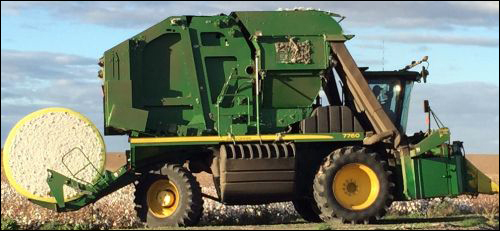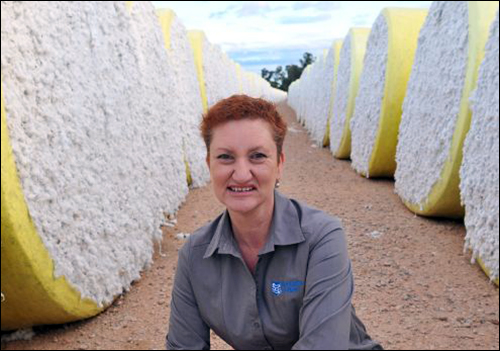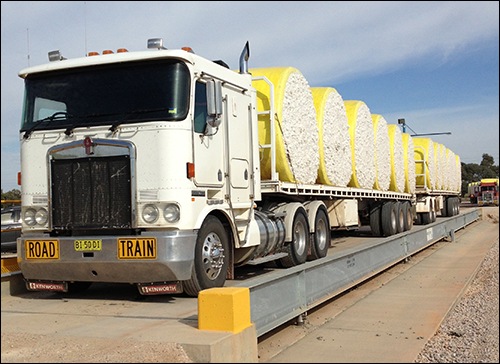Australian Cotton Gin Tracks Product to Boost Efficiency
time: 2015-09-10 14:28
RFID tags embedded in bundles of unprocessed cotton bolls help Southern Cotton track when it receives, stores and gins those bundles, and the company then shares that data with growers.
By Claire Swedberg
Ever since it opened for business three years ago, Australian cotton gin operator Southern Cotton has employed radio frequency identification to track the cotton it receives, stores and processes, and has shared that information with growers to make the ginning process and delivery to customers more efficient and error-free. Southern Cotton is now expanding the solution to enable its employees, as well as growers, to access the collected RFID data via an app on their smartphone or tablet.
Southern Cotton was founded in 2011 by a group of New South Wales cotton farmers in the Murrumbidgee Irrigation Area (MIA). The cotton industry was growing in the area, and the farmers saw a need for a local gin that could provide efficient services for growers, who had been transporting their cotton to the nearest gin some 400 kilometers (250 miles) away.

The John Deere 7760 Cotton Picker has a built-in RFID reader to link each unit of harvested cotton to its farmer, field, date, time, latitude and longitude.
After being harvested, the cotton is packed and wrapped to form modules—large, cylindrical bundles of field cotton, composed typically of 50 percent seed, 40 percent cotton and 10 percent unusable trash, and weighing as much as 2,700 kilograms (6,000 pounds) apiece. The group found that passive ultrahigh-frequency (UHF) RFID technology could make the ginning process more efficient, says Kate O'Callaghan, Southern Cotton's general manager, by creating an automatic record of each module as it was brought to the company, stored and then ginned prior to being picked up by the appropriate customer.
John Deere already provides EPC Gen 2 UHF passive RFID tags in the yellow plastic sheeting that its picking machines automatically wrap around a cotton module at the time of harvest, and its 7760 Cotton Picker comes with an onboard RFID reader. The tags, embedded in the wrap, are intended to enable harvesters to track the round module from the field to the gin. The John Deere onboard reader and computer link the tag ID automatically with the farmer, field, date, time, latitude and longitude of the module's production entered into the picker's software.
The grower can receive the RFID data captured during harvesting in the form of a text file, which is stored on a compact flash card or thumb drive plugged into the onboard computer, or on a cloud-based server hosted by John Deere, via a cellular connection.
Although many growers use the 7760 Cotton Picker and the plastic wrap with built-in RFID tags—a system known as the Harvest Identification Cotton (HIDC)—some older gins do not yet use RFID, O'Callaghan says. Southern Cotton's founders decided that their ginning operations would benefit from using the RFID tags, as would the growers.
Growers harvest cotton in their fields (known as paddocks in Australia) and bundle the bolls into modules, which are then delivered to the gin with the intention of filling a specific customer's contract. It is important that customers receive the correct bales of cotton as ordered, since cotton may be contracted up to four years in advance.
Once a cotton module is ready for processing, it is placed into the gin, the wrapper is removed, and the cotton is cleaned and molded into bales. To ensure that every cotton bale is properly identified when it is loaded onto a customer's truck, employees at cotton gins often attach a printed serial number to each bale, which must be checked against the serial number of the cotton module first delivered by the grower.

Kate O'Callaghan, Southern Cotton's general manager, surrounded by cotton modules
"We realized it doesn't make sense to assign a [printed serial] number," O'Callaghan explains, "when there's already one in the wrap that's rich with data." O'Callaghan is referring to the ID number encoded to each passive UHF RFID tag embedded in the plastic sheeting used by the 7760 Cotton Picker to bundle up each module.
So Southern Cotton hired a contractor to develop software to use the information already provided by the John Deere system, and to manage that data onsite. Prior to opening its gin, the company set up its own test area in which it attached RFID readers and antennas to a cotton scale and gin, then tested how well the tags could be interrogated, as well as how well the software—created for Southern Cotton by a local software company—could capture, store and share that data.
In 2012, Southern Cotton went live with its ginning operation, with the RFID functionality built in. The solution consists of Impinj Speedway Revolution UHF RFID readers built into the weighing scale, the circular gin and a motorized vehicle known as a "moon buggy" that not only transports bales but drives through the yard.
When Southern Cotton receives a delivery of modules from a grower, the modules are driven onto a scale in order to determine their exact weight. At that time, the product's weight, as well as information from the 7760 John Deere picker HIDC system—related to that grower, the variety of cotton and the fields where it originated—is stored in the John Deere software, along with the unique ID number on each wrap's RFID tag, which is forwarded to Southern Cotton's software.
The modules are then stored in the yard according to the grower and the cotton variety. To ensure that the modules are delivered to the proper location for storage, the buggy drives through four blocks each containing 29 rows of modules, reading every tag as it passes. That data is forwarded to Southern Cotton's software on its own dedicated server, and the software can then identify any issues that need to be addressed, such as a missing module, or one that has been stored in the incorrect location. Southern Cotton's workers can then correct the problem, ensuring that no mistakes are made prior to the ginning process, such as the wrong cotton being ginned for a given customer. The process also prevents any incidents of missing modules at the time that they are required for ginning.
When it is time to process a module, a moon buggy picks it up and delivers it to the gin, where another RFID reader captures the tag ID number, linked to details related to that module. The wrap is then removed, the field cotton is dried and cleaned to remove seed and trash, and the usable cotton is typically packed into four bales weighing approximately 227 kilograms (500 pounds) apiece. A bar-code number is attached to each bale, and the bar-code ID is linked to the data related to the module in Southern Cotton's software.
When a customer arrives to pick up the cotton bales, the bar-code numbers are scanned to verify that the correct bales have been selected. The customer can then remove the bales, and Southern Cotton can commence the billing process.

When Southern Cotton receives a delivery of modules, they are driven over a scale to determine their weight, which is then linked to the modules' ID tag numbers, captured by the scale's built-in Impinj RFID reader.
Growers can receive reports related to the weight, storage and ginning of their products, and thereby know what the weights were, the results of the ginning (how many bales of cotton were produced, for instance), and when that ginning took place. The process not only saves onsite personnel the time they would otherwise spend reading serial numbers and searching for modules, but it also prevents errors.
For the growers—typically, those with the largest volume of cotton, according to O'Callaghan—the data is also useful in helping them to analyze which fields and sections of fields are producing the most high-quality cotton.
In the meantime, O'Callaghan notes, the Murrumbidgee Valley growers are planting ever-increasing quantities of cotton. In 2011, 18,000 hectares (45,000 acres) were planted. Growers are planting 36,000 hectares (90,000 acres) this year and are expected to plant 50,000 hectares (124,000 acres) in 2016.
This year, O'Callaghan says, her company is working to develop Android- and iOS-based apps that could make it possible for onsite personnel, as well as growers, to easily view data regarding the location and status of their cotton. She expects the apps will be ready for use by the next cotton-ginning season, which will begin in April 2016.